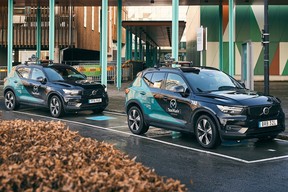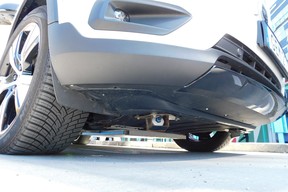Two of the big hurdles in the electric vehicle segment are concerns about range and battery size. Now, a recently completed 100-hour demonstration by Israeli startup Electreon has seen a Toyota RAV4 PHEV travel 1,942 km without stopping to charge. How is that possible? By covering the distance using Electreon's proprietary wireless powerline technology, the RAV4's lightweight 18 kWh battery never gets depleted and maintains its charge from a specially equipped line.

The Toyota RAV4 PHEV moves along the Electreon's road wireless charging test track during a world record-setting drive. ELECTRON'S PHOTO
The successful application of this technology has set a new world record for the time and longest distance a passenger electric vehicle has ever driven (non-stop). The Electreon team's goal was to drive about 1,500 kilometers in the five-day test, but instead it successfully completed the rally with 33 percent more kilometers driven.
During the continuous 100-hour driving demonstration, 56 different riders – 48 of whom are members of the Electreon team – and Israeli driver Bar Baruch joined the driving effort for more than five consecutive days. . The car will only stop momentarily to switch drivers (no engine shutdown) and never stop dedicated charging. The demonstration track is only 200 meters (one-eighth of a mile) long, with only 25% of the track electrified.

Two Volvo XC40 Recharge taxis at a wireless charging taxi station in Gothenburg, Sweden. PHOTOS OF VOLVO
According to the company, during driving, wireless EV charging technology increased the RAV4's range by at least 26 times over the current vehicle's maximum real-world range limit. That's based on the PHEV's all-electric range pegged at 75 kilometers.
The company's shared charging platform, independent of battery technology, supports multiple simultaneous users, from small passenger vehicles to large e-trucks. The appeal of this type of charging technology is clear and multi-layered, including eliminating the need for large batteries in the vehicle and providing extended, supposedly unlimited range.
With a successful attempt at a world record, Electreon's next step is to install wireless powerline technology in downtown Detroit this summer. Indeed, Detroit made TIME's "World's Greatest Places" list for being chosen as home to the United States' first electric vehicle charging path.
EV wireless charging really works
What has made this century's tram revolution so exciting to cover as a journalist is HG Wells-ian, the amazing technology combined with the PT Barnum-style hype that accompanies it. .
Who could forget battery swap stations, where you simply drag your low-battery EV into a stall and a multi-serrated machine underneath will remove the depleted battery and insert a fully charged battery in just a few minutes ? Then there was the idea that drones would be used to transport fully charged batteries to stranded electric vehicles. Or my personal favorite, the story of a Zimbabwean inventor who created an electric vehicle that doesn't charge, instead using radio frequencies to generate the energy that powers the vehicle.

The specially equipped XC40 Recharge features a wireless charger that is 14 cm taller than the charging pad. ANDREW MCCREDIE'S PHOTO
But between these outlandish ideas and the subsequent claims of their sheer authenticity (certainly accompanied by 'invest now' promotions), there are occasional real ideas. effective and put into practice. Going the 'electrified path' promises to recharge an EV just by driving along a road equipped with an electrified line. Well, there are only such 'smart' roads in certain parts of the world, including Sweden, Italy and Detroit.
The promise of EV . wireless charging
This brings us to wireless charging. Another somewhat wild concept that has been around for years as an idea. Think of charging your car like charging your smartphone on a wireless charging pad, even though the car won't touch the charging pad. Over five years ago, after picking up my cell phone, I was led into a windowless white room at Nissan's R&D lab in Yokohama to view the static display of a Nissan Leaf parked on a wide mattress. one square meter. "Wireless charging!" I was informed through an interpreter, however there are no illustrations nor details on how and if it will work.
Last year at VW's battery lab in Tennessee, there was a VW ID.4 parked on what appeared to be a similar charger in the parking lot, but when I asked my instructor about it, I was told says he has no information about it, nor will he ask anyone about it. However, I am allowed to take pictures.
Call me a skeptic, but I've started to rank wireless charging in the same category as our Zimbabwean friend. Then I went to Gothenburg, Sweden a few weeks ago and not only learned how wireless charging works, but also sat in a public taxi pulled up to the charging station and started charging. Over the past year, 20 Volvo XC40 Recharge taxis have used four wireless charging pads in the Gothenburg Green City Area, whereby designated areas of the city are used as live test sites for the development of sustainable technology. Volvo is working with Pennsylvania-based InductEV on wireless charging technology.
How does the wireless EV charging station work?
The charging station sends energy through the charging plate, which is collected by a receiver in the car 14 cm away from the charging plate. The cabs use the XC40's existing 360-degree camera system to help the driver align the vehicle with the charging pad. Each cab is equipped with a special charging adapter at the bottom of the vehicle between the front wheels. For the all-electric XC40 Recharge car, the wireless charging capacity is more than 40 kW, making the charging speed about four times faster than the wired 11 kW AC charger and almost as fast as the 50 kW DC fast charger. Wired. Even if the pad is covered with snow, ice or dirt, it still works.
Automatic charging begins when a compatible vehicle is parked on a road-mounted charging pad, in this case a taxi stop. The driver doesn't need to get out of the car, or even press any buttons to start charging. The only thing that will stop charging from working is if there is a piece of metal on the pad.
“The Gothenburg Green City area allows us to test exciting new technologies in real-world environments and evaluate them over time,” said Mats Moberg, head of Research and Development at Volvo Cars. to be introduced more widely in the future. “Testing new charging technologies with selected partners is a good way to evaluate our future automotive alternative charging options.”
Looking to the Future: Is toll infrastructure the ultimate barrier to electric vehicle dominance?
The Gothenburg Green Cities Initiative aims to achieve zero-emissions transport by 2030, using a real city as a test site. According to Moberg, Volvo's participation will allow the company to accelerate technology and service development in the areas of electrification, shared mobility, autonomous driving, connectivity and safety.
If I didn't see it with my own eyes, I still wouldn't believe it, but wireless charging for electric cars is real. Believe in technology and hype.






